Deed of Variation on Intestacy – Guide & Template
David Cammack
(Updated for 2023.) Our Deed of Variation for intestacy template provides all you need to vary the estate distribution of an “intestate” estate. This means the estate, property and assets of someone who died either:
- without any valid will; or
- they may have made a will, but no one can find it and/or no one knows its contents.
A deed of Variation on Intestacy is a legal document. It enables the allocation of a deceased person’s estate to be varied where the deceased died without leaving a will.
This guide explains how you can use a deed of Variation to vary an intestate estate. Specifically, when a person is entitled to an inheritance from someone who died without leaving a will. I.e. the person who died intestate.
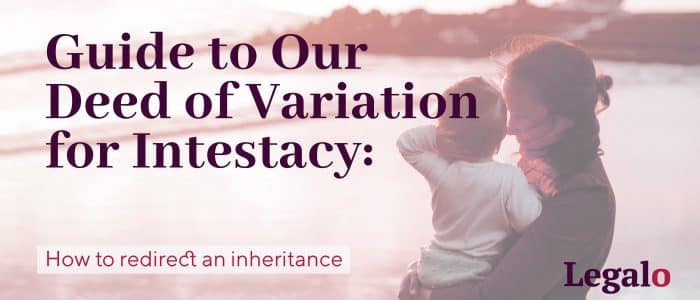
We have written this guide to familiarise you with the legal requirements for a Deed of Variation on Intestacy. It’s easy to redirect an inheritance (or part of it) to another person once you know how.
The guide also covers using our template to draft a Deed of Variation, tax ramifications as well as practical considerations to be aware of. This applies both generally and when using a Deed of Variation template as opposed to engaging a hiring solicitor.
About our deed of variation on intestacy
A well-drafted Deed of Variation can provide an effective and cost-effective way for beneficiaries to vary the apportionment of an intestate estate.
You can use a template deed of variation to enable the beneficiaries to reallocate assets in accordance with their preferences. You should note that only the beneficiaries that the intended variation affects must agree to it.
David has drafted our Deed of Variation template. David is a UK practising solicitor whose experience provides peace of mind and reliability to our clients.
Our template comes with a comprehensive guide to drafting the Deed of Variation. On average it takes our customers approximately 30 minutes to draft their Deed of Variation using the template.
This guide to our deed of variation for intestacy explains key points relating to our template. It is a summary of the full guide that the document template download includes. This guide also seeks to explain all the key concepts relating to a Deed of Variation in a simple way.
Use the template when a person entitled to an inheritance from someone who has died without leaving a will (or at least no valid will), i.e. who died intestate, now wants to redirect that inheritance (or part of it) to another person.
What is a Deed of Variation on Intestacy?
A Deed of Variation is a legal document that enables the beneficiaries of a deceased person’s estate to alter how assets are distributed.
The deceased estate can be varied whether or not there was a will in place. This process allows for the redirection of the inheritance to other individuals (or trusts). You can potentially reduce inheritance tax liabilities, depending on the circumstances, which we look at later in this guide with several examples.
If the deceased passed away leaving a valid will, then you should use a Deed of Variation of a Will. That document has different contents to a Deed of Variation on Intestacy.
Most commonly beneficiaries use a deed of Variation on Intestacy to better align the distribution of the estate’s assets with the collective wishes of the beneficiaries.
It is for this reason that people often refer to the document as a ‘Deed of Family Arrangement’. You usually carry out the variation to implement a redistribution agreed upon between the deceased’s family members.
The Legal Basis for a Deed of Variation
Section 142 of the Inheritance Tax Act 1984 (the “Act”) provides the legal basis for a Deed of Variation on intestacy. The Act requires that a Deed of Variation must meet several requirements to be valid.
These requirements are:
- You must execute the Deed of Variation within two years of the deceased’s passing.
- There must be agreement from all beneficiaries who the variation affects.
- The variation must be in writing and signed as a deed.
- The beneficiaries cannot give any monetary or other valuable consideration for their agreement to the variation. It must take effect as a gift effectively.
- You must include a statement of intent which confirms the parties’ intention to effect the variation in accordance with the tax legislation.
Legalo’s Deed of Variation makes it easy to comply with all of these requirements.
When to use the Deed of Variation
It comes with a few options for you to choose from, so it works:
1. to redirect an inheritance (or part of it); or
2. for property which was jointly owned with the person who has died in an arrangement known as a “joint tenancy” (for example their house). Due to the death, this transfers automatically to the surviving owner; or
3. to redirect an inheritance into the hands of either (a) a person entitled to inherit from the deceased’s estate or (b) a person who was not a beneficiary of the estate; or
4. where the personal representatives of the deceased have not taken out letters of administration, provided that the estate is sufficiently small that you do not need to obtain letters of administration; or
5. whether the original inheritance was due to go to one or more people, and whether you are now redirecting it to one or more people.
You can put a Deed of Variation in place before or after you or the executor have obtained a Grant of Probate (or Letters of Administration in the case of intestacy).
When not to use the Deed of Variation
Do not use this template for a person who died with a proper will. In such a situation, instead, you should use Legalo’s deed of variation for will template – click on the link.
Please note that you have a strict time limit of two years from the date of the death of the deceased to put the Deed of Variation in place.
After two years it is no longer possible to vary the beneficial entitlements arising under the intestate estate. Instead, a lifetime gift can be made by the person who has received the inheritance, but then it counts against their estate for inheritance tax purposes if they pass away within 7 years of the date of making the gift. For more on the 7-year rule, read our blog article. We have a Deed of Gift template you can use instead of this template.
Drafting a Deed of Variation
When drafting a Deed of Variation, it is critical that the document contains a clear statement of the redirection of the legacy being varied.
Anyone can draft a Deed of variation. It is however critical that its format is correct. For this reason, we recommend using a qualified solicitor or using a template from a reputable, and reliable provider.
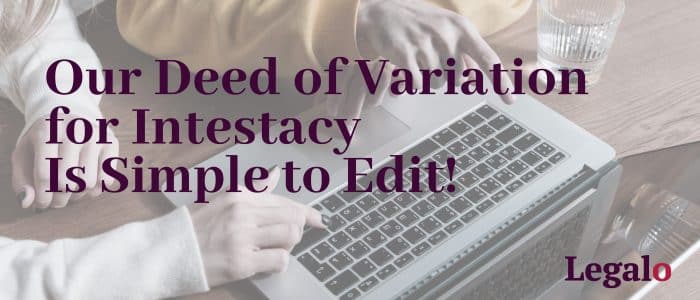
Advantages of Using a Deed of Variation on Intestacy Template
We’ll take a moment to consider in further detail the pros and cons of using a Deed of Variation Intestacy template.
- Cost savings compared to hiring a solicitor.
- Speed of document production.
- Convenience and ease of use.
- Flexibility to create a document that suits your needs.
The cost and time savings in using a template to create the Deed of Variation make it particularly appalling to many people. You can often purchase a template online for a cost of between £25 and £75.
Given the critical nature of this legal document, we recommend that you purchase a template from a trusted source.
Our Deed of Variation
Advantages Our Deed of Variation on Intestacy template is affordably priced at just £54.95. You can be assured that it is fit for purpose, as a UK solicitor experienced in producing Deeds of Variation drafted it.
Convenience is another key benefit of using a template. You can complete a template Deed of Variation in your own time. Our Deed template includes guidance and drafting notes that walk you through completing the document. We also offer a telephone support helpline should you have any questions.
Speed is also a common reason for beneficiaries to use a template to enable them to write the Deed of Variation themselves.
Hiring a solicitor involves making an appointment to instruct them. Providing them with guidance on your requirements takes time. There will usually be a process of review and feedback. Of course, you get the assurance that the final document does exactly what you expect, but that is at the cost of the expense and time taken.
How to use our Deed of Variation Intestacy template
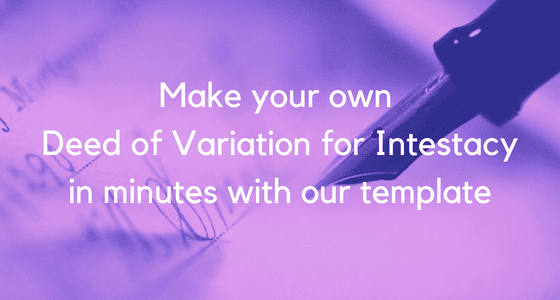
You can download the deed of variation Intestacy in Word format. It is easiest if you do this on:
- a PC computer or laptop, or
- your iPad if you have suitable word-processing software (NB most do not).
Once you have completed it, you can print it and the relevant people can sign it. We include detailed guidance notes with the Word document download to assist you.
Use the guidance notes to complete the template document with ease. They take you step-by-step through completing the document, explaining each clause as you go.
Please note that each of the beneficiaries who the deed affects should sign the deed. The personal representatives of the deceased should also sign only if the deed increases the amount of Inheritance Tax due.
For more information on the intestacy rules, as to who is can inherit in this situation, see the “In Brief” website at http://www.inbrief.co.uk/estate-law/rules-of-intestacy.htm.
If you need tax advice on the effect of the deed, you should obtain advice from a tax specialist. For example, a firm of solicitors with a good probate department. Unfortunately, giving tax advice is outside of Legalo’s remit. However, you can use our ‘Find a Solicitor’ service and we can put you in touch with a suitable probate solicitor.
Agreement of the Beneficiaries to the Variation
Any beneficiaries negatively impacted by the variation must sign the Deed of Variation.
It is not necessary that all beneficiaries of the Estate sign the Deed of Variation. However, this is common, and we recommend it as good practice. It can assist in ensuring that all beneficiaries are in agreement and that no one will seek to challenge the redirection of the legacy.
Please note that if the affected beneficiary is a minor or unborn child then court approval is necessary before the variation can be carried out.
Parental signatures on behalf of minors are not sufficient and the Deed of Variation will not be legally valid.
Tax Implications of a Deed of Variation on Intestacy
Inheritance Tax (IHT)
To meet IHT legal requirements, the Deed of Variation must include a statement that the signatories intend for the variation to take effect under Section 142 of the Inheritance Tax Act 1984.
In accordance with the Act, this requirement enables the redirected legacy to be treated as though it was made by the deceased themselves to the new beneficiary.
For IHT purposes the redirection will be treated as if it was the deceased, not the original beneficiary, that made the transfer.
Capital Gains Tax (CGT)
Similarly, a Deed of Variation on Intestacy must include a statement of intent for CGT purposes. The statement must reference Section 62(6) of the Taxation of Chargeable Gains Act 1992.
The absence of this statement could result in the variation being treated as a disposal by the original beneficiary for CGT purposes. This in turn could give rise to a CGT liability for the original beneficiary.
Limitations of a Deed of Variation on Intestacy
It should be noted that a Deed of Variation can only vary the disposition of the intestate estate.
The Deed cannot be used for other purposes such as appointing executors. If a person does without a will then their Estate does not automatically have an executor.
In such circumstances, you must apply for a document called ‘Letters of Administration’ to appoint an ‘Administrator’ of the estate. You can read further details on this at the Citizen’s Advice website.
Deeds of Variation on Intestacy & Variations After Asset Distribution
A Deed of Variation on Intestacy can be used even where the administration of the estate has been completed and the assets distributed.
It should be noted that any income generated by the assets since their distribution should also be addressed in the Deed of Variation.
Deeds of Variation on Intestacy & Double Variations
It is not possible to apply more than one variation to the same asset, or legacy. So, if an original beneficiary has varied the inheritance, using a Deed of Variation, then the new beneficiary cannot also later vary their new inheritance.
However, double variations are possible in certain circumstances. For example, if a husband passed away and left all of his assets to his wife, who then subsequently dies, both wills may be varied within two years of the first death.
This technique can in some circumstances be beneficial in optimising the use of inheritance tax allowances.
Deeds of Variation and Joint Ownership
While joint tenancies cannot be severed via a will, a Deed of Variation can be used to alter the disposition of a jointly owned asset.
However, note that practical challenges may arise when dealing with certain joint assets such as life insurance policies or joint shareholdings, where one-half of the asset is intended to pass to someone other than the joint owner.
In such circumstances, the surviving joint owner may present practical challenges and issues when engaging with the asset’s new owner.
Variations on Intestacy & the Pre-Owned Assets Tax
Deeds of Variation do not generally result in any income tax issue. However, one exception can be the Pre Owned Assets Tax (POAT).
Note, that POAT is not actually a specific type of tax. It refers to the income tax charge that applies when a person once owned an asset, transfers that asset but continues to enjoy a benefit from the asset. In such circumstances, the value of the benefit received can be taxed as income.
There is one specific exemption that exists for trusts created under a Deed of Variation in which the original beneficiary remains one of the trust’s beneficiaries.
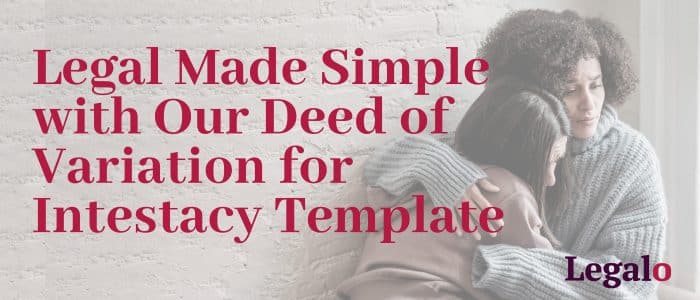
FAQS: Deed of Variation Intestacy
Do I need to register a Deed of Variation?
Generally, you do not need to register a Deed of Variation of Intestacy. There are 2 exceptions to this:
- If the variation will result in additional Inheritance Tax becoming payable (very unlikely), then you do need to notify HMRC. You do this by writing to them and sending a copy of the Deed of Variation. You can read further about the requirements: see the HMRC website.
- If you are passing on an investment asset, such as shares or an investment property that attracts capital gains tax you may have to register. registration is needed if you want to roll over the present accumulated gain from the deceased to the new owner. In this situation, you do need to register the deed of variation with HMRC. Again, check the HMRC website for the exact requirements.
What exactly is a Deed of Variation on intestacy?
A Deed of Variation on intestacy is a legal document that varies how an intestate estate is distributed. An intestate state arises when a person dies without leaving a will. I.e. they die ‘intestate’. The Deed of variation can be used by the beneficiaries of the estate who will inherit the estate according to the intestacy rules, to vary the distribution of assets based on their own agreement.
How is a Deed of Variation different from a will?
A will is a legal document that describes how an individual wants their estate to be allocated after their passing. In contrast, a Deed of Variation is a document that permits beneficiaries to change the estate’s distribution after the person’s death, irrespective of whether a will existed.
What are the essential criteria for a valid Deed of Variation?
To be valid a Deed of Variation must be entered into within two years of the death of the person whose estate the deed is varying. It is also a legal requirement that all of the beneficiaries who are negatively impacted by the variation sign the deed. I.e. anyone that is giving up all or part of their inheritance must sign the deed of variation.
Lastly, the Deed of Variation must not be entered into for any sort of payment. A person cannot pay a beneficiary to give up all or part of their inheritance.
Is it possible to use a Deed of Variation to rewrite a will?
No, a Deed of Variation cannot be used to rewrite a will. It can only be utilised to redirect an inheritance. It cannot be employed to rewrite a will or make other provisions, such as naming or changing executors.
Can a Deed of Variation impact taxes like Inheritance Tax, Capital Gains Tax, and Income Tax?
Yes, a Deed of Variation can have tax consequences. For Inheritance Tax and Capital Gains Tax, the variation must include a statement of intent for each specific tax, so the new inheritance is considered as having been made by the deceased.
Regarding Income Tax, the initial beneficiary will be liable for tax on income generated by the asset being transferred prior to the transfer (if there was any income).
Is it possible to vary the provisions of an intestacy?
Yes, a Deed of Variation can be employed to modify an intestacy. A template Deed of Variation can be used or you can hire a solicitor to produce the document.
Can a Deed of Variation be executed after the assets have been distributed?
Yes, a Deed of Variation can be created regardless of whether the estate’s administration has been finalised and the assets have been distributed. However, if the assets have been distributed, they must be retrieved and physically redirected.
What does a double variation entail?
A double variation happens when the same assets undergo more than one variation. This can occur, for example, when a spouse passes away and leaves their assets to their surviving spouse, who later dies. Both wills can be varied within two years of the first death.
Can a Deed of Variation be utilised to change the disposition of jointly owned assets?
Yes, a Deed of Variation can be used to modify the disposition of a jointly owned asset. For example, property, a life insurance policy, or a joint shareholding.
Are there any exemptions from the Pre-Owned Assets Tax (POAT) for trusts established under a Deed of Variation?
Yes, a specific exemption exists for trusts created under a Deed of Variation in which the original beneficiary continues to be one of the trust’s beneficiaries.
What is included in a deed of variation to an intestacy?
The contents of our deed of variation for an intestacy are very similar to our deed of variation for a Will, so please our separate Guide page for details of the contents.
Can you make a deed of variation to an intestacy yourself?
Yes, and with Legalo’s template for this, you will find it simple to do. Our template deed of variation will cost you far less than using a firm of solicitors.
How long does a deed of variation to an intestacy take to make?
Around 20 to 30 minutes are needed to complete a deed of variation template. If you need any extra help, please call our helpline.
Can a deed of variation to an intestacy be challenged?
The deed could be challenged if you are bankrupt. This would be the case if by diverting the inheritance away from you, you are avoiding paying off your creditors.
Examples of the use of a Deed of Variation on Intestacy
Example 1: Allocating assets to a younger generation.
Mark passed away without a Will. As a result, his estate was divided in accordance with the rules on Intestacy.
According to the Intestacy Rules, Mark’s surviving spouse (Jane) and their three children (Helen, Anne and Daniel) inherited assets.
However, Mark and Jane had always intended that their three children would inherit and Mark’s estate would be divided between the three children. Jane herself already had sufficient financial resources and assets to meet her requirements.
A Deed of Variation template was purchased and drafted by Jane. She used it to redirect the entire estate to the three children equally.
As a result, Helen, Anne and Daniel each received the portion of the estate that Jane had originally inherited.
Example 2: Decreasing the burden of Inheritance Tax
When Jane passed away she was survived by her three children Helen, Anne and Daniel. Jane died without having made a Will. She died intestate. As a result, the three children inherited her entire estate jointly.
The value of Jane’s estate exceeded the Inheritance Tax (IHT) Threshold. As a result, a significant IHT liability arose and was payable from Jane’s estate.
With the inheritance from their father Mark, Helen, Anne and Daniel were financially well off. As a result, the siblings decided to set up trusts for each of their children. They could then redirect their inheritance to the trusts.
This resulted in a reduction of the IHT liability for the estate. It also ensured that Jane’s grandchildren were provided for which had always been her intention.
Example 3: Establishing a trust for a beneficiary in need
When Daniel died intestate, his assets were distributed to his wife, Emma, and their son, Matthew. This was a result of the Intestacy Rules.
Matthew has a disability that necessitates continuous care and financial assistance. Emma, along with Matthew’s siblings, decides to utilise a Deed of Variation on Intestacy template. They want to redirect some of Matthew’s inheritance to a trust. This would be a trust specifically designed to cater to his long-term care and financial support requirements.
This action ensures that Matthew’s inheritance is managed effectively and offers him financial stability in the future. It also can mean that he does not lose out on benefits to which he would otherwise be entitled.
As you can see from our guide it is very straightforward to vary an intestate estate. The key requirement is that all the affected beneficiaries agree. You can use our deed of variation template to carry out the variation.
Guide to Clauses in our Deed of Variation for Intestacy Template
Want to read more about our Deed of Variation template? if so, please see our very similar Guide to our Deed of Variation for Will. Click on the link and scroll down the page until the heading “Clauses in this Deed of Variation for Will“.
Please ignore any references in that guide to the will. Assume we are talking about the intestacy situation. You will receive the correct guide to our Deed of Variation for Intestacy with the download when buying the template.
Do browse the full range of our Wills and Probate templates that are available.
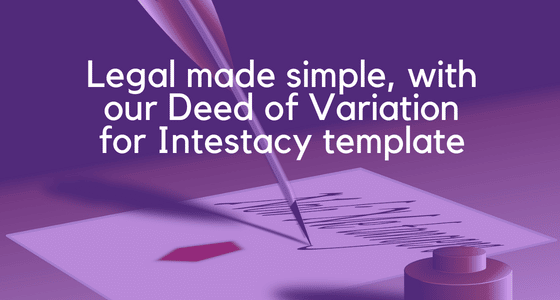
Get Legal & Compliance tips straight to your inbox, free!
"*" indicates required fields

